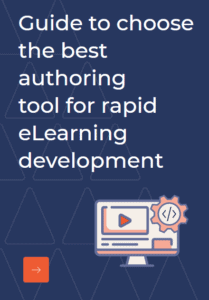Every classroom has a group of students who are attentive, a group that struggles to be attentive and another group that hardly tries. In a classroom setting the teacher/instructor/tutor usually identifies this and changes the mode of instructions or diverts the topic to grab attention. However, this approach doesn't work when it comes to deliver the learning online using eLearning modules.
Success of eLearning solely depends on if learners have really liked the what they see and if they are able to retain what they access.. This wasn't the case earlier, which was why even simple text- based courses used to serve their purpose well. With the increasing number of millennials in work place, creating eLearning that can engage the learners has become even more inevitable, after all there's just 8 second to set the impression right. So, how can this be done? Based on our experience here are some tips for creating engaging eLearning.
1. Appearance Matters
Appearances can be deceptive, but user interface or the look and feel usually plays a crucial role in attracting the learners. Though many a times adding colors into the eLearning course might not be the option, at least presenting it well with well-designed images and an innovative interface can just do the work. Hence usability is one of the key considerations while designing the eLearning courses.
2. Add Interactions, but don't Overdo it
Interactivities are usually considered to be the best way to engage learners. But, that might not be always true. Just adding a click or tap at different spots to add interactivity doesn't help if the interaction is without reason. Moreover, going overboard with click/tap functions or other controls can annoy the learners and even frustrate them. So add interactions, but only if they are required and only if the action results into a different learning element. The most useful interaction is the one which eases out the recall of the concept for the user with ease.
3. Don't make it an Information Dump
eLearning is about learning at your own convenience but it doesn't have to be an information dump. The content to be added into a course/module should be concise and relevant. Adding additional information is a good idea, but it should rather be represented as an additional bonus rather than something that is just shared randomly.
4. Do not Restrict
eLearning should be empowering not restrictive. Most of the time we design eLearning so that one step follows the other. But, what we are doing here is creating/defining a clear path for the learners to follow. However, this can be a factor that de-motivates the learners. We should rather try to create an exploratory environment where the user has the IF and OR choice.
5. Make it Challenging
Who doesn't like challenges? It's the same with eLearning. Increasing the level of complexity while the eLearning progresses can increase the interest level to a great extent. Take for instance the Candy Crush Saga, which during one point was being played by 93 Million Players every day. The game starts really easy- all you had to do is match three candies of the same color, but as the game progresses it starts to get trickier- not only does the matching become more strategic, it also has limited time and number of moves, and limited attempts too. The game managed to challenge the users and gained in terms of lives/hints purchased. This is something that we should try and incorporate in the eLearning we design to garner attention and to keep the learners engaged.
6. Add a Rewarding System
Rewards and recognitions always tend to give a forward drive. This applies for eLearning too. And gamification of eLearning can be a game changer when it comes to learner engagement. This is one of the most popular ways to get learner motivated to access the courses these days. Many organisations are also making use of Social medias effectively to keep learners engaged and hooked on eLearning platform.
7. Build Curiosity
Curiosity can be the key driver when it comes to eLearning. So, try to incorporate a good story that eventually leads towards different learning elements or promote the eLearning so that the learners think of exploring it themselves- the rest lies in how well it has been designed. Internal promotional activities within the organization can also play an important role in building engagement.
Most of the tips mentioned above revolve around John Keller's ARCS Model of Motivational Design Theory. According to the theory four steps for creating and supporting motivation in the learning process are: Attention, Relevance, Confidence, and Satisfaction. So basically focusing on these alone can give you an effective output. But, most of all the content of eLearning is what is most essential.
Keeping learners engaged is a really tricky aspect, as eLearning developers we are constantly trying to do better. Help us understand more by sharing your thoughts. Also share the aspects of eLearning that interest you the most.



